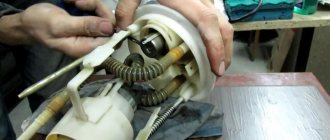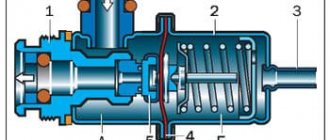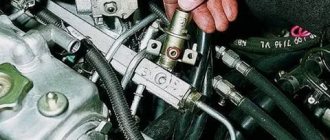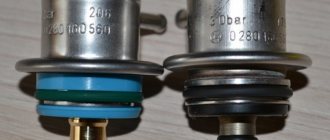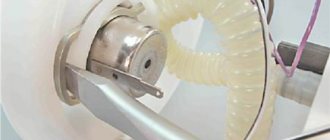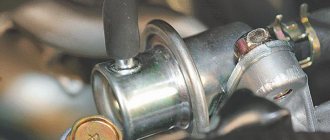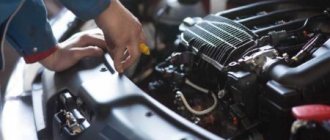The main difference between an injection engine and a carburetor engine is that fuel is supplied to the intake manifold channels under pressure - injected. But the performance of the electric fuel pump is fixed and does not depend in any way on changes in the engine’s fuel needs at different operating modes.
Excessive fuel supply to the injector rail can cause:
- over-enrichment of the mixture and excessive fuel consumption;
- excess pressure on the seals of the fuel line connections and the likelihood of leaks;
- overload of the electric fuel pump.
A lack of fuel will not allow the engine to perform at full efficiency - its power characteristics will deteriorate.
The fuel pressure regulator, connected directly to the ramp on the VAZ 21099, directs excess gasoline into the fuel tank, working as a pressure reducing valve.
Replacing the fuel pressure regulator on VAZ 2108, VAZ 2109, VAZ 21099
Welcome! The fuel pressure regulator is an integral part in the car’s power system; it is responsible for regulating the fuel pressure in the system (This is already clear from its name), for example, an injection car of the Samara family should drive at a fuel pressure of 2.8-3.2 atmospheres, if this the pressure will be less (And the pressure is directly adjusted by the regulator), then the car will begin to twitch because it simply does not have enough gasoline, but if this pressure is higher, then the consumption will immediately increase and the engine will begin to flood, if you think that the car will drive better with more pressure, then You’re wrong, it’s just that at higher pressures and air you need to supply more air to the engine, but you still have everything that’s standard, and therefore only the fuel consumption and dynamics of the car disappear.
Note! To replace this unit with a new one, you don’t need a lot of tools, but you will need some that you may not even have, namely: Hex keys are needed, because the regulator itself is attached to the bolts with hex heads, in addition to this, a screwdriver and a wrench will be needed, a “24” key is needed!
Summary:
Where is the fuel pressure regulator located? It is not located in a very convenient place, to see it you will need to crawl a little into the inside of the car engine, for clarity this regulator is indicated in the photo below with a red arrow, and in the small photo it is shown but only from a different angle (Closer ).
When should you change the fuel pressure regulator? The regulator is like a valve, if the fuel pressure in the fuel rail where it is installed is too high, it relieves this pressure, but over time it wears out and begins to jam, if it jams, then it can jam in two positions, the first position is where you will have it completely is open and therefore there will not be enough pressure in the fuel rail, and if the pressure is not sufficient, the car will begin to idle unstably, the dynamics will disappear, and after you turn off the car, the pressure will quickly drop in the fuel system (In a normally working system, the pressure in the system should remain in the region of one day, and when you turn off the car and then start it after a while, it will start without problems since the pressure will be maintained; if the regulator is faulty, the pressure will drop immediately after turning off the engine and in order to start the car you you will have to drive it a little), we figured out about low pressure, but what if the regulator gets stuck in the closed position and does not release pressure from the system, in this case the pressure in the system will increase and it will no longer be 2.8-3.2 atmospheres as it should be, but about 5-6 atmospheres, in this case gasoline will be wasted very quickly and blacker smoke will also come out of the exhaust pipe (This is because more fuel is supplied to the system) and the dynamics will drop a little.
How to replace the fuel pressure regulator on a VAZ 2108-VAZ 21099?
Note! When buying a new regulator, buy one with exactly the same marking and so that it releases exactly the pressure that is needed for your car, because different fuel pressure regulators are set to different pressures, and if you put, for example, a regulator at 5 atmospheres, then your car will also begin to consume excess fuel, blacker water will come out of the exhaust pipe and, as a result, the dynamics will disappear a little, so buy a new regulator with exactly the same markings that are on the old one (to see the markings you will most likely have to remove the fuel pressure regulator from the car)!
Removal: 1) It can be removed quite easily, you just need to know some nuances, namely, before you relieve it, bleed off the pressure in the fuel system (For more details on how to do this, read the article: “Bleeding the fuel pressure on a VAZ”), further (you don’t have to do this), we simply recommend that you turn off the power to the on-board network of the car, you will be working with an element of the fuel system, and if suddenly drops of fuel fall on the battery, then it is possible (not a fact) that this fuel will ignite, more For details on how to de-energize the on-board network, read the article: “Replacing a VAZ battery”, study the first point in this article.
2) After all completed operations to prepare the system, proceed directly to the replacement, to do this, first from the pressure regulator fitting (indicated by the blue arrow fitting), disconnect the vacuum hose and leave it hanging there in a disconnected state.
3) Now, just above the regulator, find a pressure plate (Indicated by a blue arrow), which holds two fuel pipes so that they do not dangle (Both pipes are indicated by a green arrow), and this plate is held on only by one central screw, which is what you will need Unscrew and then remove the plate from the car engine.
4) Then, from the back of the regulator, disconnect the fuel pipe that is connected to it; this pipe is secured with a nut (Indicated by a red arrow) by unscrewing it, the pipe can easily be disconnected from the pressure regulator.
5) And finally, unscrew the two side bolts with hexagonal heads that secure the regulator, to do this, take the hexagon in your hands and use it to unscrew these bolts (They are indicated by arrows).
Note! If the regulator cannot be removed, then carefully pry it from below with a screwdriver and, using it as a lever, remove it and thereby remove the regulator from the car engine!
Installation: The new regulator is installed on the car in the reverse order, but there is one But! If you decide not to change the regulator and, for example, simply removed it because you are replacing the fuel rail with a new one and you need to transfer the old one, then before installing the old one, be sure to check the O-ring and we recommend that you replace it with a new one even without checking, but still if you don’t have new ring, then there should be no defects or various kinds of cracks on the old one, keep this in mind.
Additional video: For more information on how to replace this regulator, see the video below.
Diagnostics
The serviceability of the fuel pressure regulator is checked by measuring the pressure in the fuel rail. Let's consider the algorithm for checking the pressure regulator using the example of a VAZ-2110 car with an injection power system. This car uses an injector with fuel recirculation, so the RTD is located on the fuel rail. To do this, you will need a pressure gauge, as well as a piece of oil-resistant rubber tube and two clamps. The algorithm of actions is as follows:
- We produce fuel from the ramp (we remove the fuse responsible for powering the electric fuel pump, start the engine and wait for it to stop voluntarily).
- On the ramp we find a fitting designed to relieve pressure and remove the cap on it.
- We unscrew the spool valve from the fitting (carefully and slowly, since fuel may remain in the ramp).
- We pull the tube onto the fitting and secure it with a clamp.
- We connect a pressure gauge to the tube and also fix it.
- We put the fuse back and start the engine.
- We install it on the XX motor.
- We check the pressure gauge readings (on the VAZ-2110 this parameter is 2.8-3.2 Atm.).
- We find the pipe coming from the manifold on the regulator and disconnect it from the RTD. If the device is working properly, this action will lead to an increase in pressure by 0.3-0.7 Atm.
Inconsistencies in pressure gauge readings will indicate a problem with the regulator or other system components. To accurately identify the cause of the malfunction, you need to diagnose the operation of other components.
VAZ fuel pressure regulator: causes of malfunctions and ways to solve them
An important element of the fuel system of any car is the fuel pressure regulator. The performance of the fuel system depends on how stable the fuel pressure regulator is.
The fuel pressure regulator in VAZ cars is a valve-membrane against which the regulator spring rests on the intake manifold side, and the fuel pressure on the other. After stopping the engine, it is the RTD that maintains pressure in the fuel system. If the pressure regulator is worn out, restarting the engine will require some time and manipulation of the ignition key.
The RTD is located either in the fuel tank itself, or, if the fuel system has a recirculation system (increasingly popular), then it moves to the fuel rail. The main task of the RTD is to maintain the difference between the pressure in the tank and the combustion chamber, the injector and the intake manifold. It is thanks to the operation of the fuel pressure regulator that control over the operation of the fuel injectors, the level of pressure in the fuel system is ensured, and excess volumes of fuel are returned to the tank through the return system.
The first sign of RTD malfunction
The first sign of a faulty fuel pressure regulator is increased fuel consumption. The reason for this is simple - due to problems with the RTD, excess gasoline or diesel fuel from the internal combustion chamber does not return to the tank. This leads to an increase in pressure throughout the entire fuel system; Moreover, this increase can be significant - twice or even three times higher than the norm. If the norm is 2 kilograms per square centimeter, then with a faulty RTD this figure can reach 5 and 6 kilograms per square centimeter. This situation cannot take place for a long time, since all the “weak points” of the fuel system are very quickly discovered, and one or another breakdown occurs. In turn, a malfunction in the fuel system is fraught, firstly, with breakdowns, which, in turn, will require major repairs or even a complete replacement of the engine, and, secondly, with serious situations on the road, which are no longer fraught with costs, but with a threat to health and the lives of you and your loved ones.
Speed sensor
With the transition of the nine to an injector, the measurement of vehicle speed began to be carried out not mechanically, using a special sensor that reads readings from the rotation of the gearbox gears, transmitting the readings to the computer. The block processes the readings from the sensor and sends signals to the speedometer.
Location
The VAZ 2109 speed sensor is located on the gearbox housing, you can see it by looking under the thermostat and you can find this sensor next to the gearbox dipstick.
Signs of malfunction:
- The speedometer does not work;
- The speedometer does not show the speed correctly;
- The odometer does not work;
Fuel pressure control
The fuel pressure regulator (aka FPR) is designed to maintain constant pressure in the fuel injector. On one side, a spring with a special valve exerts pressure on it, and on the other, gasoline. The bottom line is that it maintains the same pressure under different engine operating conditions, and when the load is removed, it sends an excess amount of gasoline back to the tank, thereby saving fuel and maintaining pressure in the fuel supply system.
The most common fuel regulator malfunctions
- The pressure is gone . This is why gasoline is pumped back into the gas tank and the car does not start.
- The valve becomes clogged and gasoline is difficult to flow through. As a result, gasoline begins to leak from almost everywhere. This is the most important malfunction of the pressure regulator. As soon as gasoline consumption increases sharply, you can immediately change the regulator.
- This reason is a development of the second. The valve becomes completely clogged and gasoline does not enter the fuel supply system.
- Uneven pressure . Usually caused by a stuck valve. Because of this, the car moves unevenly: it jerks or even stalls.
However, not all faults point to the valve, therefore, it is necessary, first of all, to learn how to check the pressure regulator, and then draw the appropriate conclusions.
Causes of RDP malfunctions
Most often, the valve fails due to sagging of the spring, which begins to wedge. This is caused by natural wear and tear of the metal and, unfortunately, there is no escape from it. This can also be caused by the car being idle for a long time. To prevent this from happening, the car needs to be driven more often.
The second reason why the regulator fails is low-quality fuel. Many gas stations dilute fuel with water to increase volume and make more money. Therefore, refuel only at trusted gas stations.
How to check the fuel pressure regulator of a VAZ 2110
When the first cars equipped with carburetors appeared on the VAZ assembly line, the pressure in the system was measured using the jet density created by disconnecting the valve or pinching it. However, after the market began to fill with injection cars, this method became very outdated.
Currently, pressure is measured using a pressure gauge, which is connected between the hose and the fitting. The vacuum hose must be removed. The measurement is made at idle and the measurement result is individual for each pressure regulator. Typically, the pressure rating can be found on the body of the product.
During the measurement process, after disconnecting the vacuum hose, the pressure should increase by 0.5 bar and if this does not happen, then the vacuum hose must be replaced.
Replacing the fuel pressure regulator VAZ 2110
As soon as gasoline consumption increases sharply, you can safely begin replacing the RTD. After replacing it, the pressure will normalize and gasoline will flow into the fuel supply system as before. At the same time, fuel consumption will quickly decrease.
Replacement procedure
1. Open the hood and disconnect the battery terminal. This is necessary in order to avoid accidental short circuits, which can damage devices or cause a fuel fire. Then, it is necessary to disconnect the special fitting plug to control the pressure at the end of the ramp. After removing it, a rubber O-ring will be visible inside. If it is in very poor condition, replace it immediately.
2. Using a metal protective cap, unscrew the spool from the fitting.
3. After performing the pressure gauge measurements described above, reduce the system pressure. Unscrew the two nuts that secure the fuel pipe to the pressure regulator.
4. Also unscrew the two bolts that secure the regulator to the fuel rail.
5. Slowly remove the fuel pressure regulator fitting from the rail and remove it from the fuel pipe.
6. Mount the new regulator and reassemble the components in the reverse order. It is recommended to lubricate all O-rings with gasoline. Even those rings that have lost their elasticity during use can be replaced.
That's all. This completes the replacement of the VAZ 2110 fuel pressure regulator. This operation is quite complex and involves working with gasoline-containing units. It is not recommended to carry out this work if you are feeling unwell: headache, dizziness, as this may jeopardize your health. It is best to do the work on another day or entrust all this to specialists from a car service station.
Diagnostics
If you notice characteristic signs, you should first make sure that the problem lies in the sensor. To do this you will need to do the following:
- unscrew the fitting plug, which is located on the end of the ramp block and performs the functions of monitoring the fuel pressure;
- there is a special ring at the bottom of the plug that compensates for distances - inspect it carefully;
- if the ring is damaged, has flaws, or has become less elastic, be sure to replace it with a new one;
- then, using the tire cap, unscrew the spool located in the middle of the fitting;
- Using a tire pressure gauge, which is usually used to inflate wheels, measure the pressure when the power unit is operating. Compare the resulting value with the one recommended by the car manufacturer. As a rule, it should not exceed 3.3 units.
Basically, when the vacuum hose of the sensor is disconnected, the pressure begins to increase.
If it remains at the same level, it means that the fuel pressure sensor in the VAZ 2110 ramp is definitely broken and requires replacement.
In the future, it is recommended to regularly inspect the RTD. If, after replacing a part, fuel consumption still remains high, the replacement may have been carried out incorrectly and should be carried out more carefully.
How to troubleshoot the VAZ 2110 fuel pressure regulator?
Replacing the fuel pressure regulator yourself on a car like a VAZ 2110 should not cause any special problems.
Even a beginner can cope with the task, so there is no need to immediately seek help from specialists at a service station and pay them a fairly large sum of money. In addition, not every car service center will do quality repairs.
Pressure regulator VAZ 21083, 21093, 21099, injector
The pressure regulator is an element of the fuel supply system (power system) of the injection engine of VAZ 21083, 21093, 21099 cars.
Purpose of the pressure regulator
The pressure regulator is designed to regulate the fuel pressure in the power system and maintain it within specified limits, ensuring the correct functioning of the injection system at different engine operating modes.
Location on the engine
In the fuel systems of VAZ 21083, 21093, 21099 vehicles, the fuel pressure regulator is installed on the engine fuel rail, to the left in the direction of travel of the vehicle.
Fuel pressure regulator device
The fuel pressure regulator VAZ 21083, 21093, 21099 is a membrane-type valve that opens when the fuel pressure increases and passes it through the drain line back into the gas tank. The regulator is attached to the ramp with two bolts (5 mm hexagon). The connection between the regulator and the ramp is sealed with a rubber ring. A vacuum supply hose is placed on top of the pressure regulator fitting, and a return line drain pipe is attached to the bottom using a 24 mm nut.
A membrane (diaphragm) is installed inside the pressure regulator, dividing its cavity into two isolated parts (one with fuel, connected to the ramp, the other is supplied with vacuum from under the throttle valve). The membrane is connected to a valve, which unlocks or, conversely, closes the outlet to the drain line. On the opposite side, the membrane is supported by a return spring.
Air flow sensor
The mass air flow sensor, also known as MAF, is probably the most famous and most recognizable sensor of all the sensors in a car. Its purpose is to count the air entering the engine. Air counting is necessary to create the air-fuel mixture in the correct proportions.
Location
The VAZ 2109 air flow sensor is located on the intake corrugation between the throttle valve and the air filter housing.
Signs of malfunction:
- Idle speed fluctuates;
- The car does not pull well;
- The engine stalls spontaneously;
Signs and malfunctions of the fuel pressure regulator
Welcome to the DIY car repair website. A reliable car is not one that looks beautiful, but one that rarely breaks down. Unfortunately, VAZ cars do not always please their owners, forcing them to pay a lot of attention to repairs or restoration work.
Fuel pressure control
So, one of the weakest links is the fuel pressure regulator. Due to the low quality of gasoline, it often fails, forcing you to check the VAZ fuel pressure regulator and replace it. All that remains is to find out how to diagnose the malfunction and check the functionality of the device.
The purpose of this small device
The car's system is designed in such a way that fuel flows through the injectors to the intake manifold. It is very important that the pressure does not change. In turn, the regulator makes an accurate calculation of the volume of gasoline supplied.
As a result, the device controls the pressure parameter inside two elements - the intake manifold and the fuel rail. In this case, the regulator’s task is to maintain the pressure difference at the same level. In addition, the regulator controls the pressure parameters at the injector and in the intake manifold.
A decrease in power, malfunctions of the power unit, an increase in consumption - all these are signs of a malfunction of the fuel pressure regulator (we’ll talk about this in more detail below). At the same time, the task of the car owner is to diagnose the problem in time and accurately determine whether the fuel pressure regulator is faulty or the problem lies elsewhere.
Signs and malfunctions of the fuel pressure regulator
The main sign of a problem is the appearance of malfunctions in the car. So, the following symptoms of a malfunctioning fuel pressure regulator can be identified:
- Problems starting the engine. The starter rotates, but the engine does not “support” its efforts;
- power has decreased significantly. As a rule, this is immediately noticeable when accelerating a vehicle or when driving downhill;
- The engine is unstable at idle speed. At the same time, it may stall from time to time (for example, at an intersection);
- fuel consumption increases.
There may be two reasons:
- Valve failure;
- the valve just doesn't hold.
The regulator valve has failed. In this case, excess fuel is not poured into the tank, but an increased pressure of 2.5 kg/cm2 or more is created. This problem invariably affects the amount of fuel injected into the combustion chamber. As a result, fuel consumption increases, and the gasoline itself does not burn completely.
The valve doesn't hold. In this case, there is a constant “staggering” of fuel throughout the system. As a result, the pressure decreases, and with an increase in engine speed, a clear fuel shortage occurs.
In such a situation, the power and throttle response of the power unit drops significantly. In addition, during starting, you need to turn the starter for a long time to create the necessary pressure.
Features of checking the fuel regulator
To solve the problem, it is important to know how to check the fuel regulator. This can be done using a regular pressure gauge. Everything is simple here. The device is mounted in the space between the fitting and the fuel pipe. To take measurements, the vacuum hose must be disconnected.
In this case, measurements should be made in four different modes:
- When the ignition is turned on. The nominal parameter is “three” atmospheres;
- when measured at idle – 2.5 atmospheres;
- in case of squeezing of the return flow hose - 7 atmospheres;
- with the hose removed from the pressure regulator - 3.3 atmospheres.
If the measured parameter does not correspond to the specified data or does not increase at all, then the device is faulty. In such a situation, it is enough to figure out how to change the fuel pressure regulator and perform the replacement.
Be attentive to your car, promptly respond to problems that arise, carry out diagnostics and make repairs. This is the only way to extend the life of your VAZ car and protect yourself from high costs in the future. Good luck on the roads and of course no breakdowns.
How to check an RTD with your own hands. Pro tip
There are several ways you can use to check the condition of the RTD in your garage. The “classic” option, also known as the oldest option, is to disconnect or clamp the bypass valve, while observing the force of the jet pressure. This method was popular when checking pressure on VAZs. Currently it is practically not used.
Today, the simplest and most reliable way to check is to use a pressure gauge.
It is necessary to set the engine to idle speed, then connect a pressure gauge between the fuel hose and the fitting, having first disconnected the vacuum hose. When taking measurements, the pressure in the fuel system should not rise above 0.7 Bar.
Replacing the fuel pressure regulator on a VAZ 2114
So, when the pressure in the intake pipe increases, the regulator increases the fuel pressure. If the pressure in the pipe drops, then the device reduces the pressure accordingly. To get rid of excess fuel, the valve on the device opens slightly, from where gasoline flows back into the gas tank of your VAZ 2114.
Signs of breakdown
The car itself often informs the driver that problems have arisen in a particular system. Therefore, the main task of the car owner is to learn to recognize these signs. Thus, determining the cause of the breakdown and eliminating it becomes a matter of technology.
Regulator problems
Signs of a malfunctioning fuel pressure regulator include:
- Fuel consumption increases;
- When idling, the engine suddenly stops;
- While driving, there is a significant decrease in engine power;
- It is possible to start the engine with a certain effort.
Valve problems
Loosening the nut
- If the valve of this device fails, excess fuel will not be able to pour back into the gas tank, causing the pressure in the fuel system to increase to higher values. The norm is 2.5 kg/cm2. As a result, the amount of gasoline entering the combustion chamber will increase, which is why it will not be able to burn completely.
- If the valve stops holding back the pressure, fuel will move freely throughout the entire fuel system, which will result in a drop in pressure. By increasing the speed, you simply won’t have enough fuel to accelerate. Engine power will drop noticeably. When the car stops, the pressure is maintained if the valve is working properly. But since it cannot withstand the pressure, in order to start the engine again, you will have to turn the starter for a long time in order to achieve the required level of pressure.
Checking the head pressure
The quality and efficiency of the regulator can be determined independently using a pressure gauge. You will use it to measure the pressure in the system.
Diagnostics is performed in three modes. Before starting the inspection, be sure to make sure that there is no damage in the fuel line and that fuel is not leaking anywhere. If there is damage to the line, checking the pressure pressure will not give an objective result.
Coolant temperature sensor
To measure the coolant temperature in the VAZ 2109, a special sensor is used, which serves to determine the fluid temperature and adjust the fuel mixture. The sensor changes its resistance depending on the temperature of the liquid and transmits the readings to the ECU, and the unit sends signals to the injectors to supply the required amount of fuel to warm up the car.
Location
The DTOZH on the VAZ 2109 is located in the thermostat housing; you can find it by removing the air filter box.
Signs of malfunction:
- The engine does not start well;
- The engine does not start when hot;
- Increased fuel consumption;
